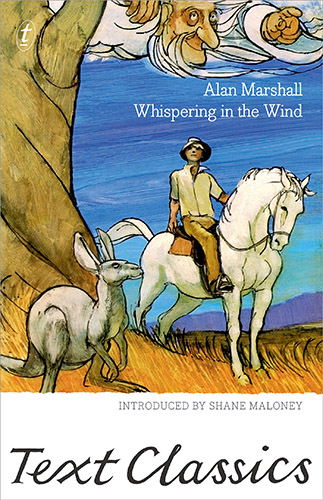Imagine that you are a six-year-old child. One day, you get a sore throat and a headache and start to feel generally icky. Your parents put you to bed. You don’t get better. Within a few days, you cannot move your legs and your back has begun to curve. You have caught an infectious disease known as poliomyelitis or infantile paralysis. It is a virus that attacks mainly children. There is no known cure. You might die. If you survive, you will spend the rest of your life as a cripple, able to walk only with your legs strapped into contraptions of steel and leather. You will be the child, the one that every primary school has, who clumps around in callipers, unable to run and skip and join in the other children’s games. Worst of all, you will become an object of pity.
Until the development of a vaccine in the 1950s, epidemics of polio periodically swept through Australia, striking down tens of thousands of children. Alan Marshall was one of them. By the time I Can Jump Puddles, the first volume of his autobiography, was published in 1955, he had been living with its effects for more than forty years. His vivid and lively memoir of his boyhood affliction and his indomitable spirit in overcoming its limitations became a beloved classic and remains the work for which he is best known. Millions of copies were sold worldwide, proving particularly popular in the former Soviet Union and eastern Europe. An award-winning film adaptation was made in Czechoslovakia in 1970 and it was produced as a television series here in Australia in 1981.
Alan Marshall enjoyed a long and prolific writing career, beginning in the 1930s and running until his death in 1984. The son of a horse-breaker, he began to write short stories while working as an accountant in a shoe factory in Collingwood during the Depression of the early 1930s. After the factory shut down, he contributed to magazines and newspapers, including a lonely-hearts column for Woman that ran for almost twenty years. His personal experience and his observation of ordinary people dealing with an unfair and oppressive social system led him to join the anti-fascist Writers’ League. During World War II, he travelled around Australia in a horse-drawn caravan, gathering messages from soldiers’ families for the A.I.F. News, a weekly paper for the troops in North Africa. Entranced by the outback and its colourful characters, he spent time in Arnhem Land living among Aboriginal people and writing a number of books about his experiences.
‘Underlying all of Marshall’s writing is a simple code,’ according to the Oxford Companion to Australian Literature, ‘grounded in an optimistic faith in humanity, that values social solidarity, tenacity, work and physical courage.’
In 1969 he published Whispering in the Wind, his first children’s book. Despite some good reviews, it failed to find a readership and eventually went out of print. A reminder of a time when the crows flew backwards to keep the dust out their eyes and the bandicoots were bigger than bullocks, it now presents itself to new generations of readers.
Like any self-respecting once-upon-a-time story, this one takes place in a world that is both strange and familiar, where the commonplace becomes magical and the most remarkable things are normal. Our hero, Peter, is a young boy who dwells in a snug little bark hut deep in the bush with Crooked Mick, an old bushman and the greatest buckjump rider in all the world.
‘Crooked Mick of the Speewah’ was a long-established mythical figure, a product of the oral tradition of the droving campfire and the shearing shed, a giant of a man who would eat two sheep for lunch and could split a fence post just by staring at it. To Marshall’s contemporaneous readers, the presence of Crooked Mick was an unmistakable signal that Whispering in the Wind was a species of bush yarn, a tall tale whose whole point lay in the inventiveness of its telling.
‘If ever you come across anyone who claims to have met Crooked Mick’, warned folklore collector Bill Wannan, ‘listen to them with deep respect, for they will be a prodigious liar.’ Marshall had written the foreword to Wannan’s definitive Yarns, Ballads and Legends of the Australian People (1954), and it is difficult not to detect an element of chiacking in his depiction of Peter’s father figure.
The little bark hut of Peter’s idyllic bush existence contains only two books, one about horses and the other about princesses. It can hardly be surprising then that Peter nurses an ambition to ride forth and rescue a beautiful princess from a dragon. According to the South Wind, a beardy old bloke who gets around a fair bit, only one such creature exists in Australia. The prisoner of a nasty king, she guarded by a fierce bunyip.
And so begins Peter’s quest. Mounted on his pony, Moonlight, his tucker bag stuffed with chops and sausages, Thunderbolt the magic stockwhip in hand, he sets forth on his rescue mission. In short order, he enlists a trusty off-sider in the form of Greyfur the Kangaroo who has the handy ability to pull anything from an elephant to a grand piano out of her pouch depending on the needs of the situation.
Onward they press, through the Whispering Grass, confronting the Jarrah Giant, the Doubt Cats and various other Creatures with Names in Capital Letters. A standout among the talking flora and fauna is the Pale Witch who, along with her broomstick and cauldron, possesses an avid interest in photography. On her nocturnal visits to sweep the moon, she pinches the cameras the Americans have left behind on their space missions, littering up the place. Even in the back of beyond, news has arrived of the landing of Apollo 11 on the moon. (Marshall sent a copy of the book to astronaut Buzz Aldrin who walked on the moon in the year Whispering in the Wind was published).
With many such winks and sly digs, the yarn gets shaggier and shaggier. But in due course, all obstacles are overcome, the hairy Bunyip is bested and the hand of the Beautiful Princess Lowana is won. It’s grilled sausages all round and everybody ends up jolly good friends.
It cannot be denied that some elements of Whispering in the Wind have not travelled well through the Shifting Sands of Time. Notwithstanding the author’s progressive credentials, the enchanted Australia he conjures is a male one, and white. Aborigines have been erased from its sweeping horizons. They live elsewhere, sidelined and compartmentalised in a ‘land of the Aborigines’ and exist solely to supply a sonorous dash of Dreamtime wisdom to get Peter’s hero-quest up and running. The fact that the Princess bears ‘an Aboriginal name’, merely serves to emphasise Indigenous absence.
And frankly, there’s not much in it for the Princess, either. Her large and comfy room is lined with artworks and bookshelves. She has wall-to-wall Persian carpet and several pet rabbits. By the time Peter climbs through her window, she’d read the Chronicles of Narnia and all three volumes of the Lord of the Rings.
It’s hard to imagine such a girl would find much enduring attraction happily-ever-after cooking and tidying a slab hut in the middle of nowhere, even if the gig includes a lot of galloping around on a white horse with her long hair blowing behind her like a stream of gold. Apart from anything else, it would be a waste of her Matriculation.
But Whispering in the Wind never pretends to be anything but a tall tale, told with tongue firmly in cheek and with a young readership in mind. Never a political polemicist, Marshall had long refused to conform to the view held by many of his comrades of the left that art should be didactic, and I fancy that some elements of the book first took root in the mind of a small boy in the backblocks of rural Victoria, bedridden and paralysed, his imagination racing ahead of his crippled body.
When the creator of the polio vaccine, Jonas Salk, was quizzed about the patent on his discovery, he said that like the sun, vaccines belong to the people. It was a sentiment with which Alan Marshall doubtless concurred. And if this new edition of Whispering in the Wind canvasses questions about race and gender and matters of national identity, I don’t doubt he’d agree that was a good thing, too.
This is the introduction to the Text Classics edition of Whispering in the Wind, released on 3 September 2018. Details here.





